History of Painting in the Český Krumlov Region
A significant chapter of the history of creative art within the Český Krumlov region is made from the development of the art of painting. Its development is closely connected with the historical development of this region. Settlement of the region came rather late, in comparison with other regions of Bohemia, it is one of the important factors, as to why we do not find any Romanesque architecture with mural painting.
In the course of time as the colonisation went on in the 13th century changes came about. Artistic activity was influenced very fundamentally by the presence of the residential town of Český Krumlov, and the two Cistercian monasteries in Vyšší Brod and Zlatá Koruna and we also can not ignore the importance of the Marian pilgrimage church in Kájov. These ecclesiastical institutions were very distinguished recipients of works of art, often with the support of the Rosenbergs who were really open-handed donors and to whom art had the function of representing the family. Thanks to their prominent position in the Czech kingdom, many cultural influences radiated from Praha, where the royal court lived. The art of Czech painting only had its centre in the workshops in Praha. We also can not forget the inspiration coming from Austria and Germany which was very easy due to the location of the Český Krumlov region. Traditionally it was also a Catholic region and it was the reason why the artistic continuity was not interrupted during Hussitism and why the works of art were not destroyed at that time as happened in other regions of the Czech kingdom. The panels were at first imported especially from the Praha workshops and local artistic activity back to the 15th century when in connection with the Hussite wars Český Krumlov became for a short period of time the culture and political centre of the Kingdom.
 |  |
Many of the panels were made during the Gothic period. They were the parts of folding wing altars or they were hung up in the church interiors. Some of the smaller works of more intimate character served also for private prayers. The Marian cult had a dominating place in the Czech environment that was related to the spiritual climate of that time. The monumental cycle of nine panel paintings dedicated to the Vyšší Brod Monastery were made in the middle of the 14th century. The work of which an anonymous Praha artist is called Master of the Altar in Vyšší Brod, reached quality high enough to be compared to other European works and significantly influenced further development of Czech panel painting. The artist in his work excellently blended influences from Western Europe with Italian and Byzantine elements. The Italian influence could be seen especially in the use of light, colour, beauty and softness.
 The painter masterfully
managed masterly to capture people's feelings such as a mother's
tenderness, joy, and amazement, but there is also sadness and
suffering in his work. He drew attention to details as charming as
animals and flowers. The themes of his pictures which are today
placed in the National Gallery in Praha, are arranged in three
levels that are connected with the childhood of Christ, his
suffering and celebration. The connecting figure became the Holy
Virgin in compliance with the Marian consecration of the monastery
church. The pictures making up the altar were probably donated to
the church by Peter
I. von Rosenberg who is pictured on the Nativity picture. The
importance of the customer reflected the high standing of the
painter. Another significant work has also connected with the Vyšší
Brod monastery. It is the of Vyšší Brod Crucifixion (the National
Gallery) that was painted around 1380 probably also in Praha. The
picture is notable for its gold background, variety of colour and
the pathos of the figures. The strong Italian influences, that
greatly inspired Czech panel painting of the 14th century, are
again recognisable. The panel with the Enthroned Madonna with St.
Margaret and Catherine is also proof of these influences (Aleš´s
Gallery of South Bohemia in Hluboká nad Vltavou). It is dated
around 1360 and probably dedicated to the monastery in Zlatá
Koruna.
The painter masterfully
managed masterly to capture people's feelings such as a mother's
tenderness, joy, and amazement, but there is also sadness and
suffering in his work. He drew attention to details as charming as
animals and flowers. The themes of his pictures which are today
placed in the National Gallery in Praha, are arranged in three
levels that are connected with the childhood of Christ, his
suffering and celebration. The connecting figure became the Holy
Virgin in compliance with the Marian consecration of the monastery
church. The pictures making up the altar were probably donated to
the church by Peter
I. von Rosenberg who is pictured on the Nativity picture. The
importance of the customer reflected the high standing of the
painter. Another significant work has also connected with the Vyšší
Brod monastery. It is the of Vyšší Brod Crucifixion (the National
Gallery) that was painted around 1380 probably also in Praha. The
picture is notable for its gold background, variety of colour and
the pathos of the figures. The strong Italian influences, that
greatly inspired Czech panel painting of the 14th century, are
again recognisable. The panel with the Enthroned Madonna with St.
Margaret and Catherine is also proof of these influences (Aleš´s
Gallery of South Bohemia in Hluboká nad Vltavou). It is dated
around 1360 and probably dedicated to the monastery in Zlatá
Koruna.
 Many panels were also
painted in the 15th century. The continuity of artistic production
was not violently interrupted during Hussitism because Ulrich
II. von Rosenberg, who was the head of the Czech Catholic
aristocracy, made Český Krumlov the culture and diplomatic centre
of the country. Many church dignitaries, members of aristocracy and
artists fled to Český Krumlov and they consequentially influenced
the development of art in that region. The cultural tradition of
the high court of pre-Hussite Praha was taken-up again in Český
Krumlov. The tradition of the beautiful style was especially strong
and this style developed in Bohemia from the eighties of the 14th
century and stayed in the Český Krumlov region until late into the
15th century. The beautiful style was especially linked with the
Holy Virgin pictures and it was characteristic for its emphasis
upon an ideally refined beauty of the figure dressed in a folded
robe and flooded with unreal light. Under the influence of the
beautiful style the picture called Madona Zlatokorunská (Madonna of
Zlatá Koruna), (National Gallery), which was dedicated to the
Zlatá Koruna Monastery, was painted around 1410 before the
Hussite wars. The picture's composition is in the style of the
Madona Svatovítská (Madonna of St. Vitus) where Madonna and her
child turn their faces to the observer. The panel of Madona
Vyšebrodská (Madonna of Vyšší Brod) (National Gallery, today again
in the Vyšší Brod monastery) was painted in some workshop in Praha
around 1420. It was influenced by the latter period of the
beautiful style. A wide painted frame with figurative decoration
representing male and female saints is characteristic of this
picture. It was influenced by the Byzantine art of painting, that
was brought of Bohemia from the north of Italy.
Many panels were also
painted in the 15th century. The continuity of artistic production
was not violently interrupted during Hussitism because Ulrich
II. von Rosenberg, who was the head of the Czech Catholic
aristocracy, made Český Krumlov the culture and diplomatic centre
of the country. Many church dignitaries, members of aristocracy and
artists fled to Český Krumlov and they consequentially influenced
the development of art in that region. The cultural tradition of
the high court of pre-Hussite Praha was taken-up again in Český
Krumlov. The tradition of the beautiful style was especially strong
and this style developed in Bohemia from the eighties of the 14th
century and stayed in the Český Krumlov region until late into the
15th century. The beautiful style was especially linked with the
Holy Virgin pictures and it was characteristic for its emphasis
upon an ideally refined beauty of the figure dressed in a folded
robe and flooded with unreal light. Under the influence of the
beautiful style the picture called Madona Zlatokorunská (Madonna of
Zlatá Koruna), (National Gallery), which was dedicated to the
Zlatá Koruna Monastery, was painted around 1410 before the
Hussite wars. The picture's composition is in the style of the
Madona Svatovítská (Madonna of St. Vitus) where Madonna and her
child turn their faces to the observer. The panel of Madona
Vyšebrodská (Madonna of Vyšší Brod) (National Gallery, today again
in the Vyšší Brod monastery) was painted in some workshop in Praha
around 1420. It was influenced by the latter period of the
beautiful style. A wide painted frame with figurative decoration
representing male and female saints is characteristic of this
picture. It was influenced by the Byzantine art of painting, that
was brought of Bohemia from the north of Italy.
Probably in the twenties of the 15th century the painting workshop of the Master of the Zátoň Altar was established in Český Krumlov. From that time it was possible to come across the work originating in this region. The painter's work mainly came from the tradition of Czech painting from the first quarter of the 15th century. He was not a first class painter but for all that his work influenced the production of this region. Around 1425 he made Zátoňská Archa (Ark of Zátoň) (the wing altar) dedicated to the church of St. John the Baptist in Zátoň village (National Gallery). The underlying connection and similarity between the suffering of St. John the Baptist and Christ's passion is the main theme of the paintings. The Votive altar from Přední Výtoň village was also probably issued from the workshop of the Master of the Zátoň Altar. It was made at the beginning of the forties of the 15th century. The panels of the altar represent Saint John the Baptist, Salome, Heroiada, Saint Margaret and the female donor. An emblem in the picture probably belonged to Jan Rous z Čermin who was in the Rosenbergs´ service.
Another painting workshop operated during the following period and it probably reached its zenith in the fifties of the 15th century. It was the workshop of Mistr Nesení kříže (Master of Carrying the Cross) from Vyšší Brod. Three panels of his production were preserved, that were parts of the altar decorated with the Marian themes and the themes relating to Christ. These panels were painted for the monastery Vyšší Brod. The theme of Christ Carrying the Cross, after which this anonymous painter was called, is shown on one of the panels. The works are again from the tradition of Czech painting from the first quarter of the 15th century, but several details already show the late period of its origin. Among these details we can see for example construction of drapery, planning and emptiness of expression and some of factors typical for Český Krumlov production. Here there also appears some less important influences from Austria. Several other works dedicated to Český Krumlov might be connected with the workshop of this Master. The influences of this workshop are also shown in the picture of the Annunciation from the Vyšší Brod monastery from the late fifties. This picture represents the very late period of the traditional production but the Italian influences, characteristic of the production of the previous century, are also noticeable here. The new tendencies are shown in the style of the panel painting of the Madonna of St. Vitus from Vyšší Brod that was made at the same period as the above mention work and was probably painted in some workshop in Český Krumlov. But this work already has the influence of some new artistic stimulation that very slowly went to the Late Gothic style.
In the nineties of the 15th century the extensive cycles of twelve panels was ordered for the lavishly rebuilt late Gothic Marian Kájov Pilgrimage Church. This cycle was made as a part of the altar of Holy Apostles. The donor, well-educated priest Michael Pils from Kájov, who was merited for the development of the pilgrimage place in Kájov, was also to be seen in the picture of the Martyrdom of Saint Simon. The paintings expressed the Martyrdom of each of apostles. All scenes are situated in an open very realistically painted landscape or in interiors. A wondrous calmness is expressed in the faces of all apostles and their tormentors that slowly turns into an expression of passivity. This work was made quite professional and it was strongly influenced with the art of Viennese paintings and was probably made in some workshop in Upper Austria. The Kájov pilgrimage church was also decorated with rich wall-paintings. The decoration of the northern antechamber is still preserved today. The dominating factor of this antechamber is the Madona Ochranitelka s pláštěm (Madonna Guardian dressed in a robe) hiding the petitioners under it. Other works made in the Late Gothic style are also connected to the Vyšší Brod monastery. They are the painted panels of saints forming the altar and panel painting of the Crowned Holy Virgin. The pictures from the monastery gallery were painted around 1500 and they were very strongly influenced by the Swabian art of painting.
The Late Gothic style began to be applied in this region from the middle of the 15th century, especially in architecture and sculpture that reached very high standard. The art of painting was much more conservative and it drew upon the traditions of the previous period. In comparison with other regions of South Bohemia the inspirations of the new Late Gothic Period influenced the art of painting very slowly. Even the amount of imported works increased. These tendencies were connected to weaker position of the Rosenbergs in the political as well as the cultural life of the country. So it happened that the royal town České Budějovice took over the initiative in the art of painting. Here in České Budějovice a unique synthesis of the beautiful style and new influences from Swabia and the Austrian regions and was reached.
In comparison with Gothic, painting in the Renaissance style was used especially in a secular environment and it was focused particularly in the residential towns of the last Rosenbergs in Český Krumlov and the castle of Rožmberk nad Vltavou. Many churches were rebuilt in the Late Gothic style in the Český Krumlov region in the previous period. Many of them were furnished with moveable furniture and that was the reason why painting production was not used as much as before in sacred areas. Also we can not forget the influences of the decay of the ecclesiastical institutions in the 16th century that also touched the monasteries in the Český Krumlov region, and the whole change of the spiritual climate to the disadvantage of the churches. In spite of this very interesting wall paintings in the church of Saint Margaret in Horní Planá village, dated between 1530 - 1580, have been preserved. The paintings on the lower part of the church gallery show the Holy Virgin, Saint Catherine and Saint Lawrence surrounded with a decoration of rich leafwork.
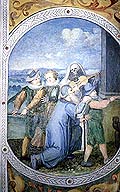 |  | 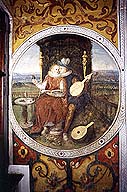 |  |
In the same way many Gothic castles were reconstructed as comfortable Renaissance residences the Rožmberk nad Vltavou Castle was also renovated in the second half of the 16th century. These renovations were finished in the beginning of the 17th century when the interiors were decorated with very rich paintings. The paintings were made in connection with arrival of the new owner Zrinský ze Serynu, Jan and his marriage to Marie Magdalena z Kolovrat. Jan Zrinský received Rožmberk nad Vltavou in 1600 from his uncle, Peter Wok von Rosenberg and he owned it until his precocious death in 1612. The painted decorations were concentrated particularly on the representative Knight's hall where the remarkable cycle of Mannerist wall paintings was preserved until today. Mannerism, coming especially from the Italian environment and in Bohemia presented especially at the court of Rudolf II, represented a reaction to the exhaustion and hopelessness of the end Renaissance. It was used particularly in the art of painting, sculpture and the general decoration of the interiors. The nature and bizarre motives, stress on the colours and combination of different materials are characteristic of this style. All of these were meant to lead a unique artificial impressiveness. The decoration of the Knight's hall in the Rožmberk nad Vltavou castle were made by an unknown painter in conformity with foreign graphic model was in a similar spirit. A wooden panelled ceiling richly covered with a painted grotesque decoration by L. Kilian with allegories of the people's characters by Marten de Vos (it is a kind of ornament made of tendrils, twigs and ribbons in which the flowers, fruit and trophies are put). The painter showed Ten levels of man's life by Crispin de Passe in five bays. It was quite a well known Renaissance theme that showed a human being's life from childhood to old age with the stress on those virtues and vices of period of life shown. The allegories of the Five Senses by Marten de Vos are painted on the vaults of windows. Three painted Reapers with hour-glasses and the motto from an evangelist Orate et vigilate (wake and pray) are painted behind a tiled stove in the corner of the room illustrating the transition of the world.
The most unique part of the whole hall is a music niche made for a group of musicians. It is the semi-circle space separated from the hall by an ornamental grille. The Mannerist wall paintings imitate architectural constructions and sculptures. The painter painted a fictitious view of rocky mountain uplands with a group of singing nymphs playing musical instruments on the front wall. The painting is finished with imitation precious stones decorating the painted jewels of the nymphs and it is wholly of the Mannerist style. The music niche represents a work of art of very high quality and shows also the living standard of the Czech aristocracy at the time of late Renaissance. The same painter who decorated the Knight's hall, also painted the cycle of wall pictures with the theme of Planets that were also dedicated to the Rožmberk nad Vltavou castle. The remains of Mannerist wall paintings showing the pious Father and Christ at the Column were preserved in the chapel of the castle.
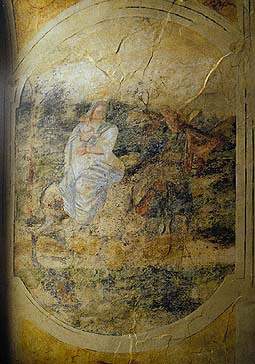 The period of the Baroque
style again brought a growing interest in sacred art in relation to
the spiritual climate of the 17th and the first half of the 18th
centuries. As the slow re-growth in Catholicism went on after the
battle of Bílá Hora in 1620, many of the churches, monasteries,
chapels and pilgrimage places in Bohemia were reconstructed and
many of them were newly built. In comparison with previous periods
we do not meet any paintings of as high quality or as significant
as the work of the Master of the Altar in Vyšší Brod or Mannerist
paintings from the Rožmberk nad Vltavou castle (except, of course,
the Schwarzenbergs´ residence in Český Krumlov). They are only
works that are not above average for the production of that period.
A network of the parish churches in the Český Krumlov region was
completed and thanks to the renovations of the Gothic period the
churches also satisfied demands on space. It was the main reason
why neither more significant reconstruction in the Baroque style
nor construction of a new church was made, except the pilgrimage
church of Panna Marie Sněžná (Holy Mary the Snow) in Svatý Kámen.
The Baroque renovations were not essential and they touched mainly
interiors and acquisition of new furnishings. These tendencies
especially reached a peak in the 18th century that is linked to the
improving situation after the Thirty Years´ War. And we also should
not neglect the traditional conservatism of this region.
The period of the Baroque
style again brought a growing interest in sacred art in relation to
the spiritual climate of the 17th and the first half of the 18th
centuries. As the slow re-growth in Catholicism went on after the
battle of Bílá Hora in 1620, many of the churches, monasteries,
chapels and pilgrimage places in Bohemia were reconstructed and
many of them were newly built. In comparison with previous periods
we do not meet any paintings of as high quality or as significant
as the work of the Master of the Altar in Vyšší Brod or Mannerist
paintings from the Rožmberk nad Vltavou castle (except, of course,
the Schwarzenbergs´ residence in Český Krumlov). They are only
works that are not above average for the production of that period.
A network of the parish churches in the Český Krumlov region was
completed and thanks to the renovations of the Gothic period the
churches also satisfied demands on space. It was the main reason
why neither more significant reconstruction in the Baroque style
nor construction of a new church was made, except the pilgrimage
church of Panna Marie Sněžná (Holy Mary the Snow) in Svatý Kámen.
The Baroque renovations were not essential and they touched mainly
interiors and acquisition of new furnishings. These tendencies
especially reached a peak in the 18th century that is linked to the
improving situation after the Thirty Years´ War. And we also should
not neglect the traditional conservatism of this region.
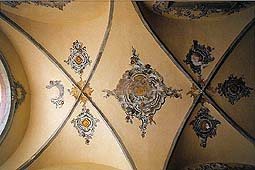 The monasteries in Zlatá
Koruna and Vyšší Brod were provided with new altar and wall
paintings step-by-step. The refectory in Zlatá Koruna was very
richly decorated in 1685 with frescos referring the events of The
Old Testament. The painted facade of the vicarage in Kájov is
interesting evidence of Baroque painting. In 1667 one of the
supporters of this Marian pilgrimage place painted a cycle of
pictures from a grievous rosary. The paintings, that were preserved
only in pieces, have a linking theme with fifteen paintings of the
mysteries of the rosary painted on a plate that decorated granite
columns lining a pilgrimage path from Český Krumlov to Kájov. The
painted decorations were also in the newly founded church of Panna
Maria Sněžná in Svatý Kámen. The not so extensive Baroque frescos
in the presbytery were later repainted and destroyed in last forty
years of our century.
The monasteries in Zlatá
Koruna and Vyšší Brod were provided with new altar and wall
paintings step-by-step. The refectory in Zlatá Koruna was very
richly decorated in 1685 with frescos referring the events of The
Old Testament. The painted facade of the vicarage in Kájov is
interesting evidence of Baroque painting. In 1667 one of the
supporters of this Marian pilgrimage place painted a cycle of
pictures from a grievous rosary. The paintings, that were preserved
only in pieces, have a linking theme with fifteen paintings of the
mysteries of the rosary painted on a plate that decorated granite
columns lining a pilgrimage path from Český Krumlov to Kájov. The
painted decorations were also in the newly founded church of Panna
Maria Sněžná in Svatý Kámen. The not so extensive Baroque frescos
in the presbytery were later repainted and destroyed in last forty
years of our century.
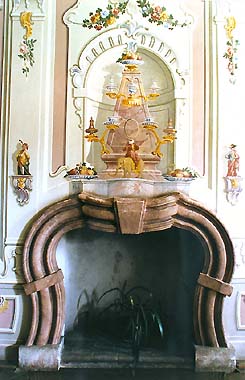 In the 18th century the
production of painting was specially concentrated on Zlatá Koruna
monastery, that reached its peak under its last abbot Bohumír
Bylanský (1755 - 1785). Then, within the reforms of Josef II, the
monastery was abolished. The vault of the presbytery of the
monastery's church was decorated with a large fresco presenting an
imaginary view into the heavens where Christ is in the company of
angels and saints is waiting for the coming of his Mother of
Heavenly glory. The fresco is an open continuation of the altar
picture of Assumption of the Virgin by the local monk Lukáš Planck.
But the picture was repainted in the 19th century. The fresco on
the side walls of the presbytery pictured the events connected with
the foundation of the monastery by the Czech king Přemysl Otakar
II. A rich painting and stucco decoration is also seen in the
monastery's ambulatory. The Rococo wall paintings presenting the
events from life of Saint Bernard who was the founder of
Cistercians were again made by Lukáš Planck. At that time the
Rococo painter František
Jakub Prokyš also worked in Zlatá Koruna. He decorated the
monastery's chapel of Holy Angels in 1767. Prokyš, who especially
worked for the Schwarzenbergs, participated on the decorative
painting of a number of secular and church monuments. We can see in
his work the influence of the Rococo style of the southern German
region joined with the inspirational influence of French Rococo
painting.
In the 18th century the
production of painting was specially concentrated on Zlatá Koruna
monastery, that reached its peak under its last abbot Bohumír
Bylanský (1755 - 1785). Then, within the reforms of Josef II, the
monastery was abolished. The vault of the presbytery of the
monastery's church was decorated with a large fresco presenting an
imaginary view into the heavens where Christ is in the company of
angels and saints is waiting for the coming of his Mother of
Heavenly glory. The fresco is an open continuation of the altar
picture of Assumption of the Virgin by the local monk Lukáš Planck.
But the picture was repainted in the 19th century. The fresco on
the side walls of the presbytery pictured the events connected with
the foundation of the monastery by the Czech king Přemysl Otakar
II. A rich painting and stucco decoration is also seen in the
monastery's ambulatory. The Rococo wall paintings presenting the
events from life of Saint Bernard who was the founder of
Cistercians were again made by Lukáš Planck. At that time the
Rococo painter František
Jakub Prokyš also worked in Zlatá Koruna. He decorated the
monastery's chapel of Holy Angels in 1767. Prokyš, who especially
worked for the Schwarzenbergs, participated on the decorative
painting of a number of secular and church monuments. We can see in
his work the influence of the Rococo style of the southern German
region joined with the inspirational influence of French Rococo
painting.
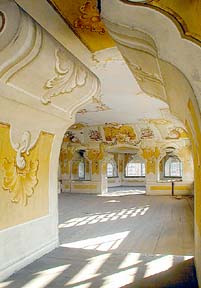 | 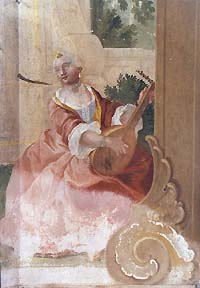 |
We can also see the wall paintings in a secular environment - in the Schwarzenbergs´ summer Červený Dvůr Castle near Chvalšiny and in Kvítkův Dvůr near Český Krumlov. There is a fine Rococo decoration of the China hall in Červený Dvůr painted by the above mentioned František Jakub Prokyš in the fifties of the 18th century. His paintings were also preserved in the interiors of Kvítkův Dvůr. It was a farm yard situated near the castle park in Český Krumlov. Rococo painting had an intimate character and it was often connected with the country castles and summer houses. It gave them a beauty with its colourfulness and lightness. The period of the Baroque and Rococo painting of this region ended at the beginning of the 19th century with an extensive fresco based on themes from the Bible. It was painted in the main hall of the library of the Vyšší Brod monastery. The ceiling painting was made by the local monk Lukáš Vávra still in the style of Baroque painting.
 Charles
Louis Philippot
Charles
Louis Philippot
 The work of the writer
from Horní Planá Adalbert
Stifter (1805 - 1868) is linked with secular production in the
Český Krumlov region. When Adalbert Stifter was young he was
influenced by Romanticism and he painted landscapes. His painting
and literary work refer to his native Šumava Hills. Adalbert
Stifter painted the Šumava landscape and also local significant
monuments - for example Čertova Stěna (Devil's Wall), the ruins of
Vítkův Kámen, Frymburk, etc. The influence of Romanticism, that
apart from an interest in nature also brought a very strong
connection to history, manifesting itself during the construction
of the famous Crusaders' gallery in Rožmberk nad Vltavou castle.
The counts of Buquoy who owned Rožmberk from the 17th century,
slowly rebuilt the whole residence as the family museum. Part of it
was also the above mentioned Pseudo-Gothic Crusaders' gallery with
the paintings of B. Strobl. The paintings made between 1857 - 1860
were copied from the originals, which were located in Versailles
and they showed famous historical personalities who participated in
the Crusade, including several members of this family. Apart from
this gallery with its romantic influence, a valuable collection of
the Renaissance and specially Baroque pictures was established in
Rožmberk castle. We can admire the works of the Baroque painters
such as K. Škréta, J. Kupecký and V. V. Reiner.
The work of the writer
from Horní Planá Adalbert
Stifter (1805 - 1868) is linked with secular production in the
Český Krumlov region. When Adalbert Stifter was young he was
influenced by Romanticism and he painted landscapes. His painting
and literary work refer to his native Šumava Hills. Adalbert
Stifter painted the Šumava landscape and also local significant
monuments - for example Čertova Stěna (Devil's Wall), the ruins of
Vítkův Kámen, Frymburk, etc. The influence of Romanticism, that
apart from an interest in nature also brought a very strong
connection to history, manifesting itself during the construction
of the famous Crusaders' gallery in Rožmberk nad Vltavou castle.
The counts of Buquoy who owned Rožmberk from the 17th century,
slowly rebuilt the whole residence as the family museum. Part of it
was also the above mentioned Pseudo-Gothic Crusaders' gallery with
the paintings of B. Strobl. The paintings made between 1857 - 1860
were copied from the originals, which were located in Versailles
and they showed famous historical personalities who participated in
the Crusade, including several members of this family. Apart from
this gallery with its romantic influence, a valuable collection of
the Renaissance and specially Baroque pictures was established in
Rožmberk castle. We can admire the works of the Baroque painters
such as K. Škréta, J. Kupecký and V. V. Reiner.
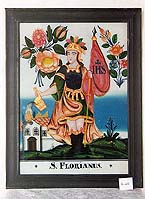 | 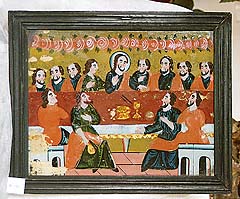 | 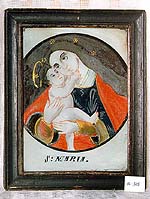 |
Quite a separate chapter of the history of the painting within this region is represented by a production of folk glass under-painting that was typical in the 19th century in the Šumava region. The centre of this folk art was in Pohoří na Šumavě village where there was a glass-works. The beginning of this production went back to the seventies of the 18th century and ended in 1900. The glass under-paintings were usually sold in the pilgrimage places and markets from where the village people brought them to their homes. These pictures were famous specially among common people and made indispensable decorations for the rooms. The themes of these pictures were secular. On these pictures we can find the Holy Virgin, Christ and saints, who represented the guardians of the house and family.
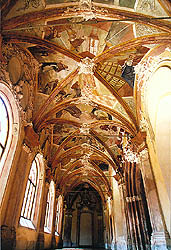 | 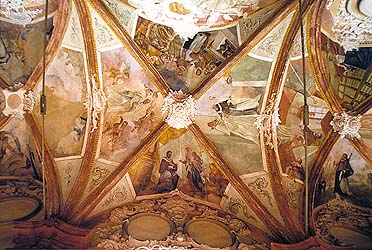 |
The oldest preserved painting workshop in the Český Krumlov region was established in the 14th century because the region itself was settled quite late. That is a reason why we can not find here any Romanesque wall paintings like in other regions of Bohemia. The development of art in the Český Krumlov region was significantly influenced by presence of the residential town of Český Krumlov, two important Cistercian monasteries in Vyšší Brod and Zlatá Koruna and the important Marian pilgrimage church in Kájov. A very important factor was also the advantageous borderland position of this region, thanks to this the Austrian, German and Italian inspirations came to here. The painting of this region reached its peak in the Gothic period in the important work of the Master of the Altar in Vyšší Brod and in the next century when thanks to the Catholic family of the Rosenbergs the continuity of art was not interrupted during the Hussite wars. Another peak of the production of painting came with the 17th century when the Knight's hall in the Rožmberk castle was uniquely decorated. During other periods the art of painting developed successfully but the art never reached the same high level of quality and importance.
(zp)
Further information:
History of Painting in Český Krumlov



